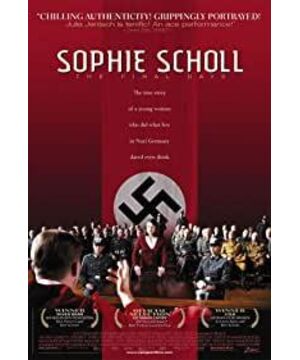In the context of European culture, the word "martyr" inevitably has a religious connotation in it. As for female martyrs, it can't escape the shadow of Joan of Arc, not to mention the Joan of Arc films by many film masters. In contrast, the modern image of Joan of Arc in Sophie Sauer is rarely successful.
The image of the martyr in the movie should not be rigid and rigid, becoming a rigid totem deliberately (or intentionally) created by later generations, a concept of walking. When the martyr was "canonized", it was also the second death. He and she were no longer the famous and real people, but only reduced to "martyrs". From this, we can also see that the director's title is intentional. This is the last few days of telling a real person.
Julia Jentsch's title character is quite successful in accomplishing this core mission of the film, aptly portraying Sophie Sauer's strong and weak sides; The green young girl, the red sweater on her body is particularly sharp and ominous. Although it is difficult to hide her fear in the face of interrogation, she firmly guards her conscience with the brute force of a young man. The short moment of sunshine and blue sky will make her completely intoxicated. In terms of shaping the characters and achieving the director's core idea, the film is remarkable in terms of strength and details. What impressed the audience in particular was that even when Sophie Sauer, played by Yulia, faced the interrogation of the Gestapo, there was always a slight smile on the corner of his mouth, and the "spirit" of the character suddenly appeared calm and straight. is a convincing modern Joan of Arc.
The whole film focuses on Sophie Sauer's arrest, liberation, interrogation, sentencing and execution, emphasizing the grim tones and "sounds" of the Gestapo asylum and prison - the director pays great attention to highlighting the various types of intimidating prisons The sound, the heavy prison door, the guard's pace, and the screams of torture, these sounds that are common in ordinary prison films are deliberately amplified to set off the protagonist's temperament. This method is very successful and is the most commendable part of this film.
The whole film uses a lot of close-up and close-up to capture the facial expressions of the protagonist of the title, which inevitably reminds people of Dreyer's "The Passion of Joan of Arc". The film also features Sophie Sauer's prayers in large close-ups. The director and screenwriter are also quite credible in dealing with beliefs. Before the execution, the priest's consolation is real and not cheap, but it emphasizes the theme of suffering.
However, the film's shortcomings and failures are also obvious. A glaring failure comes at the end of the credits, when the Gestapo interrogating Sophie Sauer reappears, throwing a sympathetic and remorseful look at Sophie Sauer. Perhaps the director and writers were trying to show the repulsive character's personality shift, and Sophie's moving power. In the previous interrogation scene, the Pilate-like Gestapo wanted to deal with Sophie leniently. He thought he was generous and offered probation conditions, but was categorically rejected—this is a conflict scene with a fatalistic nature, the old and cold-blooded. The previous generation and the new generation with ideal blood. When the Gestapo, played by the famous actor Gerald Alexander Held, handed Sophie Sauer over to the Inquisitor, his eyes vividly expressed the character's physical appearance, which was already a mummified corpse devoured by power and lies. The director and screenwriter superfluous, creating a kind of "reconciliation" atmosphere at the end of the credits, but damage the meaning that the interrogation scene has conveyed before.
The biggest flaw is also at the end of the film, when Sophie Sauer learns from the female jailer that her sentence is actually "destruction" instead of the three months stipulated in the procedure, and her life is only a few hours later. . She let out a hysterical scream and slumped back in her chair. After the powerful impact of this moment, the director made an unconvincing treatment: along with Sophie Sauer's farewell letter to her boyfriend, the lyrical piano soundtrack similar to light music sounded. I guess the director's intention was to induce tears through changes in rhythm and intensity, but unfortunately this attempt was too formulaic, which not only greatly reduced the intensity, but also made the subsequent series of scenes—farewell to parents and comrades in arms seem fake and a little boring . The answer is obvious. When it comes to death, the director is timid. But having said that, aside from Kislowski, I haven't seen a director who has the courage and strength to express a real execution, which is nothing more than a bit of pretense, "water injection" and "sublimation" of literary accent.
In the place where courage is most needed, the director reduced the intensity of the film twice and took a more formulaic safety shortcut. However, this did not affect the film's success in shaping the image of the protagonist. 4 stars minus.
View more about Sophie Scholl: The Final Days reviews











